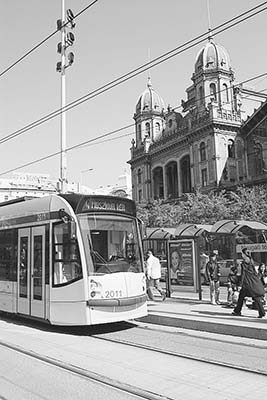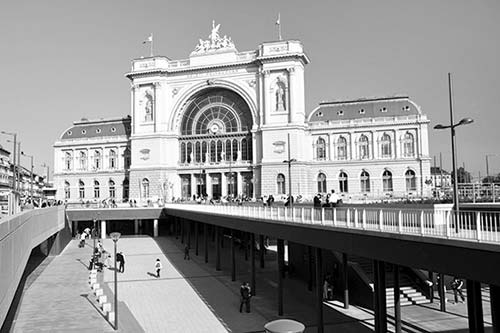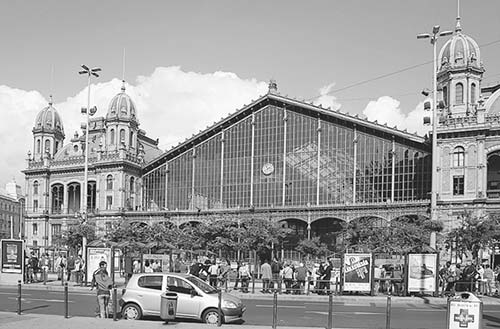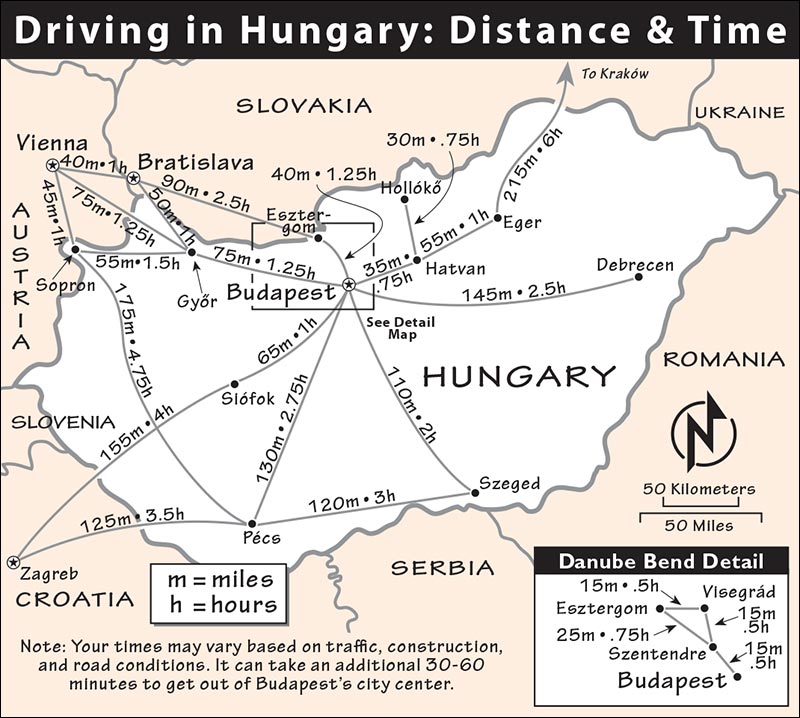
TRAIN CONNECTIONS FROM BUDAPEST
Map: Driving in Hungary: Distance & Time
Budapest is the hub of transportation for all of Hungary; from here, train lines and expressways fan out like spokes on a wheel. This chapter covers arrivals and departures by train, bus, plane, car, and riverboat.
Budapest has three major train stations (pályaudvar, abbreviated pu.): Keleti (“Eastern”) Station, Nyugati (“Western”) Station, and Déli (“Southern”) Station. A century ago, the name of the station indicated which part of Europe it served. But these days, there’s no correlation: Trains going to the east might leave from the Western Station, and vice versa. Even more confusing, the station used by a particular train can change from year to year. Before departing from Budapest, it’s essential to carefully confirm which station your train leaves from.
The Keleti/Eastern train station and the Nyugati/Western train station are both cavernous, slightly run-down, late-19th-century Erector-set masterpieces in Pest. The Déli/Southern train station—behind Castle Hill in Buda—mingles its dinginess with modern, concrete flair.
All three stations are seedy and overdue for renovation. This makes them a bit intimidating—not the most pleasant first taste of Budapest. But once you get your bearings, they’re easy to navigate. A few key words: pénztár or jegypénztár is ticket window, vágány is track, induló vonatok is departures, and érkező vonatok is arrivals. At all stations, access to the tracks is monitored: You might have to show your ticket to reach the platforms (though this is very loosely enforced).
The taxi stands in front of each train station are notorious for ripping off tourists; it’s better to call for a taxi (or, better yet, stick to public transit). For tips on this—and on using the Metró system to connect into downtown Budapest—see “Getting Around Budapest” on here.
Here’s the rundown, station by station:
Keleti train station (Keleti pu.) is just south of City Park, east of central Pest. The station faces a pretty, split-level, newly renovated plaza called Baross tér, with stops for two different Metró lines (M2/red and M4/green).
On arrival, go to the front of long tracks 6-9 to reach the exits and services. Several travel agencies masquerading as TIs cluster near the head of the tracks. A handy ATM is just to the left of the main door (and two more ATMs are inside banks that face the square out front). There’s no official TI at the station, but the railroad runs a customer service office with train advice and basic city info (near the front of track 9, in the left corner, near the ATM).

Along track 6, from back to front, you’ll see a side door (leading to a beautifully restored arrivals hall, and an exit to a taxi stand), Interchange exchange booth (with bad rates—use the ATM instead), international ticket windows (nemzetközi jegypénztár), grubby gyro stands, and the classy Baross Restaurant (described later). Pay WCs are down the hall past the gyro places.
Across the main hall, more services run along track 9, including domestic (“inland”) ticket windows and lockers. The big staircase at the head of the tracks leads down to more domestic ticket windows, WCs, telephones, and more lockers.
To get into the city center, the easiest option is to take the Metró: Heading down the main stairs where the tracks dead-end, you’ll pass through a grubby ticket area, and then (on your right) a public transit ticket and information office (a handy place to pick up a transit ticket, if you need one). Just beyond that, the underpass opens up: Turn left to reach the M2/red Metró line, or right to reach the M4/green Metró line.
I’d avoid taxis—the ones waiting alongside the station (through the exit by track 6) are likely to be dishonest, but you can try asking for a rough estimate: the fair rate to downtown should be no more than 2,000 Ft. If you must take a taxi, it’s far more reliable to phone for one (call 211-1111 or 266-6666, tell the English-speaking dispatcher where you are, and go outside to meet your taxi).
Eating at Keleti Station: Baross Restaurant, at the head of track 6, captures some of the turn-of-the-20th-century gentility that this grand station once enjoyed. A time warp with dingy woodwork, chandeliers, and fake marble, it serves up tired Hungarian classics worth considering if you want a meal while waiting for your train (2,000-3,000-Ft main dishes, daily 8:00-20:00). Your other eating options inside the station are a nearby bakery and some unappealing gyro stands.
Shopping near Keleti Station: Roughly across the street from the station is the Arena Plaza shopping mall (Mon-Sat 10:00-21:00, Sun 10:00-18:00, Kerepesi út 9, tel. 1/880-7000, www.arenaplaza.hu).
Nyugati train station (Nyugati pu.) is the most central of Budapest’s stations, facing the Great Boulevard on the northeast edge of downtown Pest. The square in front of Nyugati Station is slated for a complete renovation over the next few years. Expect the station area to be torn up, and many of the services or tram stops mentioned here may be temporarily relocated. Look for signs or ask officials for help.
Most international arrivals use tracks 1-9, which are set back from the main entrance. From the head of these tracks, use the stairs or escalator just inside the doors to reach an underpass and the Metró (M3/blue line), or exit straight ahead into a parking lot with buses and taxis. Note that the taxi drivers here are often crooked—it’s far better to call for your own cab (see instructions and taxi phone numbers described previously for Keleti Station).

Ticket windows are through an easy-to-miss door across the tracks by platform 13 (marked cassa and információ; once you enter the ticket hall, international windows are in a second room at the far end—look for nemzetközi jegypénztár, daily 7:30-19:00). Lockers are down the hall next to the international ticket office, on the left. An ATM is just inside the main door, on the right.
From the head of tracks 10-13, exit straight ahead and you’ll be on Teréz körút, the very busy Great Boulevard—and, quite likely, a chaotic, torn-up construction zone. In front of the building should be the stop for the handy trams #4 and #6 (which zip around Pest’s Great Boulevard ring road); to the right are stairs leading to an underpass (use it to avoid crossing this busy intersection, or to reach the Metró’s M3/blue line); and to the left is the classiest Art Nouveau McDonald’s on the planet, filling the station’s former waiting room. (Seriously. Take a look inside.)
Shopping near Nyugati Station: Next door is the huge, American-style WestEnd City Center mall (complete with a Starbucks; most shops open Mon-Sat 10:00-21:00, Sun 10:00-18:00, entrance next to track 1, www.westend.hu).
In the late 19th century, local newlyweds caught the train at Déli train station (Déli pu.) for their honeymoon in Venice. Renovated by the heavy-handed communists, today the station—tucked behind Castle Hill on the Buda side—is dreary, dark-stone, smaller, and more modern-feeling than the other train stations. From the tracks, go straight ahead into the vast, empty-feeling main hall, with well-marked domestic and international ticket windows at opposite ends. A left-luggage desk is outside beyond track 1. Downstairs, you’ll find several shops and eateries, and access to the very convenient M2/red Metró line, which takes you to several key points in town: Batthyány tér (on the Buda embankment, at the north end of the Víziváros neighborhood), Deák tér (the heart of Pest, with connections to two other Metró lines), and Keleti train station (where you can transfer to the M4/green Metró line).
There’s no telling which station any given train will use, especially since it can change from year to year—always confirm carefully which station your train leaves from. Remember, for specific schedules, check www.bahn.com or www.mav-start.hu.
From Budapest by Train to Destinations in Hungary: Eger (every 2 hours direct, 2 hours, more with transfer in Füzesabony, usually from Budapest’s Keleti/Eastern Station), Pécs (every 2 hours direct, 3 hours; a few more connections possible with transfer at suburban Budapest-Kelenföld station), Sopron (6/day direct, 3 hours, more with transfer in Győr), Visegrád (trains arrive at Nagymaros-Visegrád station, across the river—take shuttle boat to Visegrád; hourly, 50 minutes, usually from Budapest’s Nyugati/Western Station), Esztergom (hourly, 1.5 hours, usually from Budapest’s Nyugati/Western Station, may be discontinued due to construction—if so, take the bus, described later), Kecskemét (hourly, 1.5 hours), Szeged (hourly, 2.5 hours). Note that Nagymaros (the station for Visegrád) and Esztergom are on opposite sides of the river—and on different train lines. To reach Szentendre and Gödöllő, take the suburban HÉV line (see “By HÉV,” later).
By Train to International Destinations: Bratislava (that’s Pozsony in Hungarian, 7/day direct, 2.75 hours; more with transfers), Vienna (that’s Bécs in Hungarian, every 2 hours direct on express Railjet, 3 hours; more with transfers), Prague (3/day direct, 7 hours, more with transfers in Győr and/or Vienna; plus 1 night train/day, 8 hours), Kraków (1 direct night train/day, 10.5 hours; otherwise transfer in Břeclav, Czech Republic), Zagreb (2/day direct, 6-7 hours), Ljubljana (1/day direct, 9 hours; additional options with transfers, 8-10 hours, no convenient night train), Munich (5/day by express RailJet, 7.5 hours, additional options with transfers; 1 direct night train/day, 9 hours), and Berlin (1/day direct, 12 hours; 1 night train/day, 13 hours).
By HÉV: Budapest has its own suburban rail network, called HÉV. For tourists, this is mostly useful for reaching Szentendre (from M2: Batthyány tér) and Gödöllő (from M2: Örs vezér tere). For more on the HÉV system, see here.
Buses can be relatively inexpensive, but are typically slower and less convenient than trains. You can search bus schedules at the (Hungarian-only) website www.menetrendek.hu (click on “VOLÁN Menetrend”). Budapest lacks a single, consolidated bus station; instead, buses fan out from several points around town, each one next to—and named for—a Metró stop. (While these aren’t all “bus stations” in the strict sense, they are handy transit hubs.) A few are particularly useful for tourists:
From the Újpest-Városkapu bus station (on the M3/blue line), buses depart about hourly to trace the Danube Bend around to Szentendre (30 minutes), Visegrád (1.25 hours), and Esztergom (2 hours).
The Stadionok bus station (on the M2/red line) serves Eger (2/hour, 1.75-2.25 hours) and Lázár Lovaspark (sporadic departures, ride about 50 minutes to Domonyvölgy stop).
The Árpád híd bus station (on the M3/blue line) has buses taking the faster overland route to Esztergom (1-2/hour, 1.25 hours).
The Népliget bus station (on the M3/blue line) is mostly used by international buses (including to Bratislava: 2/day, 3 hours), as well as buses to Pécs (5/day direct, 3.5-4.5 hours). Trains are faster to these destinations.
Orange Ways Buses: For long-distance international journeys, consider Orange Ways buses, which offer affordable express connections from Budapest to Bratislava (1-4/day, 2.5 hours), Vienna (3-4/day, 3 hours), Kraków (5/week, 6.5 hours), Prague (1-4/day, 6.5-7.5 hours; this same bus sometimes continues to Dresden and Berlin), and more (www.orangeways.com).
Budapest’s airport is 10 miles southeast of the center (airport code: BUD, tel. 1/296-7000, www.bud.hu). Many Hungarians still call the airport by its former name, “Ferihegy.” The airport’s lone passenger terminal is, perhaps optimistically, called “Terminal 2” (“Terminal 1” closed in 2012). The terminal has two adjacent parts, which you can easily walk between in just a few minutes: the smaller Terminal 2A is for flights from EU/Schengen countries (no passport control required), while Terminal 2B is for flights from other countries. Both sections have ATMs and TI desks (open daily 8:00-23:00 in 2A, and daily 10:00-22:00 in 2B). Car rental desks are in the arrivals area for 2B.
From the Airport to Budapest: The fastest door-to-door option is to take a taxi. Főtaxi has a monopoly at the taxi stand out front; figure about 6,000-7,000 Ft to downtown, depending on traffic.
The airport shuttle minibus is cheaper for solo travelers, but two people will pay only a few dollars more to share a taxi (3,200 Ft/1 person, 4,790 Ft/2 people; minibus ride to any hotel in the city center takes about 30-60 minutes depending on hotel location, plus waiting time; tel. 1/296-8555, www.airportshuttle.hu; if arranging a minibus transfer to the airport, call at least 24 hours in advance). To save time, you can book your transfer at their handy desk inside the baggage claim area, or wait until you’re out in the arrivals lobby. Because they prefer to take several people at once, you may have to wait awhile at the airport for a quorum to show up (about 20 minutes in busy times, up to an hour when it’s slow—they can give you an estimate).
Finally, there’s the cheap but slow public bus #200E. This stops at both Terminal 2A and 2B, and runs in about 25 minutes to the Kőbánya-Kispest station on the M3/blue Metró line; from there, take the Metró the rest of the way into town (entire journey covered by basic 350-Ft transit ticket, allow about an hour total for the trip to the center).
To Eger: Eger makes an enjoyable small-town entry point in Hungary for getting over your jet lag. Unfortunately, there is no direct connection there from Budapest’s airport. The easiest plan is to ride the airport shuttle minibus to Budapest’s Keleti/Eastern train station, then catch the Eger-bound train from there. Or, to save a little money, you could take public bus #200E to Kőbánya-Kispest, ride the M3/blue Metró line to Deák tér, and transfer to the M2/red Metró line, which stops at both Keleti Station (for the train to Eger) and Stadionok (for the bus to Eger).
Avoid driving in Budapest if you can—roads are narrow, and fellow drivers, bikes, and pedestrians make the roads feel like an obstacle course. Especially during rush hour (7:00-9:00 and 16:00-18:00), congestion is maddening, and since there’s no complete expressway bypass, much of the traffic going through the city has to go through the city—sharing the downtown streets with local commuters. The recent wave of roadwork and other construction around Budapest only complicates matters. Signage can be confusing. Don’t drive down roads marked with a red circle, or in lanes marked for buses; these can be monitored by automatic traffic cameras, and you could be mailed a ticket.

There are three concentric ring roads, all of them slow: the Small Boulevard (Kiskörút), Great Boulevard (Nagykörút), and outermost Hungária körút, from which highways and expressways spin off to other destinations. Farther out, the M-0 expressway makes a not-quite-complete circle around the city center, helping to divert some traffic.
Parking: While in Budapest, unless you’re heading to an out-of-town sight (such as Memento Park), park the car at or near your hotel and take public transportation. Public street parking costs 175-525 Ft per hour (pay in advance at machine and put ticket on dashboard—watch locals and imitate). Within the Great Boulevard, it’s generally free to park from 20:00 until 8:00 the next morning (farther out, it’s free after 18:00). But in some heavily touristed areas, you may have to pay around the clock—in any event, check signs carefully, and confirm with a local (such as your hotelier) that you’ve parked appropriately. Also, be sure to park within the lines—otherwise, your car is likely to get “booted” (I’ve seen more than one confused tourist puzzling over the giant red brace on his wheel). A guarded parking lot is safer, but more expensive (figure 3,000-4,000 Ft/day, ask your hotel or look for the blue Ps on maps). As rental-car theft can be a problem, ask at your hotel for advice.
To Eger and Other Points East: Head out of the city center on Andrássy út, circling behind Heroes’ Square to access Kós Károly sétány through the middle of City Park. You’ll pass Széchenyi Baths on the left, then (exiting the park) go over the Hungária körút ring road, before getting on M-3. This expressway zips you conveniently to Eger (exit #114 for Füzesabony; go north on road 33, then follow road 3, then road 25 into Eger). Between Budapest and Eger, M-3 also passes Gödöllő (with its Royal Palace; also exit here for the Lázár Lovaspark horse show) and Hatvan (where you can exit for Hollókő).
To Bratislava, Vienna, and Other Points West: From central Pest, head over the Danube on the white, modern Elisabeth Bridge (Erzsébet híd). Once in Buda, the road becomes Hegyalja út; simply follow Bécs-Wien signs to get on M-1.
To the Danube Bend: For tips on driving around the Danube Bend (Szentendre, Visegrád, and Esztergom), see here.
In the summer, Mahart runs high-speed hydrofoils up the Danube to Vienna. It’s not particularly scenic, and it’s slower than the train, but it’s a fun alternative for nautical types. The boat leaves Budapest at 9:00 and arrives in Vienna at 15:30; on the return trip, a boat leaves from Vienna at 9:00 and reaches Budapest at 14:30 (May-late Sept only, departs from Budapest Tue, Thu, and Sat; from Vienna Wed, Fri, and Sun). The trip costs €99 one-way between Budapest and Vienna (or €109 the other direction). To confirm times and prices, and to buy tickets, contact Mahart in Budapest (tel. 1/484-4010, www.mahartpassnave.hu) or DDSG Blue Danube in Vienna (Austrian tel. 01/58880, www.ddsg-blue-danube.at).
For details on taking the boat to Danube Bend towns (Szentendre, Visegrád, and Esztergom), see here.